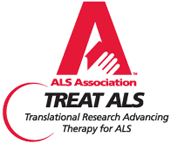
March 15, 2006
The ALS Association Funds Primate Study Prior to Clinical Trials as Part of Its New Program TREAT ALS
[QUICK SUMMARY : The ALS Association is funding a safety trial in rhesus monkeys to confirm the safety of a proposed antisense treatment for ALS before the drug can be put into human clinical testing.]
 The ALS Association announced funding for a safety study in 20 rhesus monkeys that will confirm the safety of a proposed treatment that lowers production of a mutant protein linked to some inherited cases of amyotrophic lateral sclerosis (ALS, also called Lou Gehrig’s disease). In rat models, researchers have demonstrated that the antisense drug, ISIS 333611, inhibits the mutant protein copper-zinc superoxide dismutase (SOD1), a molecule associated with an aggressive form of ALS. Based on these findings, researchers believe this drug has the potential to be an effective treatment for patients with this type of ALS. Researchers hope that the antisense approach will also prove useful in other ALS patients as well as for targeting new genes that are found linked to the disease. ISIS 333611 is an antisense compound discovered in collaboration with Isis Pharmaceuticals (Nasdaq:ISIS).
The ALS Association announced funding for a safety study in 20 rhesus monkeys that will confirm the safety of a proposed treatment that lowers production of a mutant protein linked to some inherited cases of amyotrophic lateral sclerosis (ALS, also called Lou Gehrig’s disease). In rat models, researchers have demonstrated that the antisense drug, ISIS 333611, inhibits the mutant protein copper-zinc superoxide dismutase (SOD1), a molecule associated with an aggressive form of ALS. Based on these findings, researchers believe this drug has the potential to be an effective treatment for patients with this type of ALS. Researchers hope that the antisense approach will also prove useful in other ALS patients as well as for targeting new genes that are found linked to the disease. ISIS 333611 is an antisense compound discovered in collaboration with Isis Pharmaceuticals (Nasdaq:ISIS).
“The potential of this therapeutic approach is very exciting for ALS patients carrying the SOD1 mutation,” said Lucie Bruijn, Ph.D., ALS Association science director and vice president. “We are pleased that through TREAT ALS, we are able to support such important efforts and move them rapidly from the lab to the clinic.” [Treat ALS stands for Translational Research Advancing Therapy for ALS, which is ALS Association’s research initiative to prioritize and bring promising compounds into clinical trials in a focused approach.]
Investigators Timothy Miller, M.D., Ph.D. and Don Cleveland, Ph.D. of the Ludwig Institute, University of California, San Diego and Richard Smith M.D. of the Center for Neurologic Study plan to further test the safety and activity of ISIS 333611. In some patients with inherited ALS, SOD1 is produced with changes, or mutations, that lead to toxic results, producing the loss of motor neurons. While the exact mechanism of toxicity is not yet documented, the death of motor neurons is undoubtedly the result.
Lowering the production of SOD1 using ISIS 333611 has shown positive results in a rodent model that recapitulates an inherited type of ALS. Miller, Cleveland, and Smith have shown that antisense treatment aimed at SOD1 mutation in rats prolongs survival. Time of treatment for the rats was near onset of symptoms, reflecting the scenario for actual patients who often have definite and even advanced signs of motor neuron loss by the time of ALS diagnosis.
“Advancing this antisense drug forward represents an important step in developing a novel approach for the treatment of familial ALS,” said Don W. Cleveland, Ph.D., Professor of Medicine, University of California, San Diego. “Because of the specificity of antisense drugs in targeting disease-associated proteins, ISIS 333611 currently represents the only viable approach for inhibiting the expression of SOD1 in patients. If we can replicate the findings we observed in rat models, in monkeys, and decrease the amount of mutant SOD1 in the brain, this drug could potentially modify or halt the progression of ALS in patients.”
To confirm and extend the safety documented in the rats to non-human primates, the investigators will contract with an outside facility to study 20 monkeys who will receive the antisense candidate delivered by an implanted pump connected by tubing into the fluid surrounding the spinal cord (cerebrospinal fluid or CSF). The study will use the same equipment appropriate for human use. Delivery directly into the CSF is also the approach the investigators envision for human trials.
The FDA requires this type of safety study prior to entry into clinical trials. The monkey study of the antisense treatment will collect data over 90 days on how well different doses of the drug are tolerated, and general clinical parameters, including assessment of liver, kidney and nervous system function. Pharmacokinetic studies will be performed to determine how long the Isis compound stays in the bloodstream and neural tissue to help guide dose selection. In addition, effects on SOD1 in various primate tissues will be measured to demonstrate pharmacological activity.
For more information about RNA therapies such as antisense, click here.
The Miller and Cleveland publication on RNAi treatment of SOD1 mutant rats can be found here.
For more information about Isis Pharmaceuticals Inc. please visit: http://www.isispharm.com
This work has been supported from its inception by The ALS Association as well as grants from the NIH and the Scripps Research Institute.
